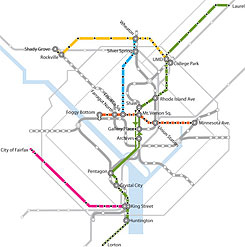Regional plan recommends regional bike sharing but disjointed bus improvements
The K Street Transitway, a network of priority bus corridors, regional bike sharing, a few Metro station improvements, and two freeway bus lines in Virginia will make up the DC region’s application for the competitive “TIGER” grants that USDOT will award from the federal stimulus.
The regional Transportation Planning Board will review the entire package on Wednesday, to allow regional staff to complete the application by the September deadline. Regional bike sharing is very exciting. The rest of the package contains many great improvements, but like many of TPB’s products, is more a compilation of individual jurisdictions’ uncoordinated priorities than a true regional system.
TPB, part of the regional Council of Governments (COG or MWCOG), is often called a “stapler” because most of their reports end up assembling submissions from the various jurisdictions, rather than providing an actual regional vision. The team started with a concept of creating regional, high-quality bus lines to really demonstrate the potential of rapid buses, and ended up with a series of lines many of which don’t even connect to one another. Instead of improving a few lines to very high quality, the plan is a patchwork of incremental changes, with some signal priority here, a queue jumper lane there, and some improved fare payment technology over there.
Virginia, in particular, has chosen to put most of its eggs in two freeway baskets, asking for $170 million to build a few freeway ramps to get buses on and off of I-66 and I-95 HOT lanes. Meanwhile, the entire package of bus corridor improvements in the rest of the region totals only $93 million. The region would do better allocating its money to more significant improvements on existing commercial corridors. The plan notes that these freeway projects might not be “shovel-ready” enough for the TIGER grant, and therefore might be dropped after August 1st.
The one truly regional element of the plan is the bike sharing system, which asks for $10 million to build a 1,600 bicycle system “at 160 bike stations in core urban areas of DC, Alexandria, Arlington, Silver Spring and Bethesda.” We discussed this idea in March, and it’s good to see it in the program. At least regional officials could agree on that much.
There are also three station improvements in the proposal. A pedestrian tunnel under Rockville Pike at the Medical Center Metro would enhance access. Rosslyn, one of the busiest stations, would get a new entrance with three “high-capacity elevators,” a new mezzaning, and emergency stairs. And a new Takoma-Langley transit center would consolidate bus stops into a new, indoor facility, simplifying transfers.


